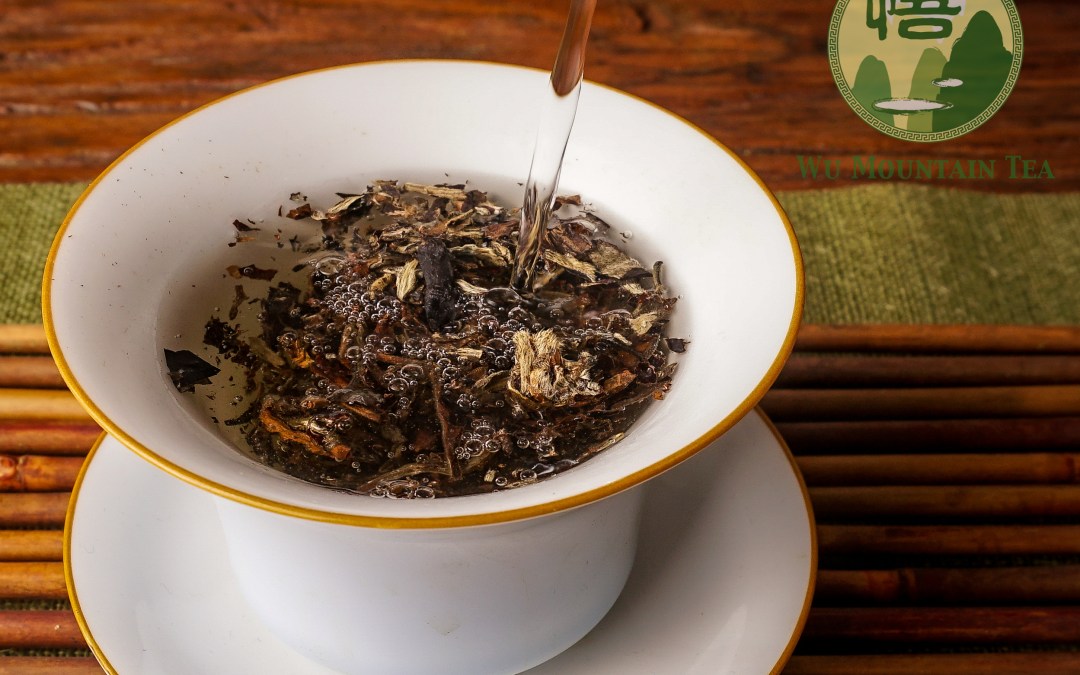If steeping instructions on the packaging call for 2 minutes at 80°C/175°F … why? How did they arrive at that recipe? Why not 1 minute… or 5 minutes? And what about Gongfu Cha with many small infusions… is the first infusion different from the 10th?
We hold an innate understanding of some science behind tea infusion, like that 1 minute does not extract enough, while 5-minutes might be more than we like. But what is actually happening as your tea leaves bathe in hot water for extended periods of time? This post will explain what types of compounds are extracted from tea leaves into water, what factors affect that process, and how those compounds interact with each other to collectively create the thing we love… flavor.

To start, two categories of tea leaf compounds are essential to understanding extraction science and tea flavor – polyphenols and amino acids. These two categories of bioactive compounds dance a tango every time we make tea.
Polyphenols. ~25-40% of tea leaf dry weight and the backbone to many purported health benefits of tea consumption. Anti-oxidant [1-4], anti-carcinogenic [5], lipid-lowering [6], antidiabetic [7], anti-inflammatory [8], antibacterial [9], neuroprotective [10-12], anti-depressive [13-15] (we can do this all day). Really, the scientific community has gone a little nuts with the tea polyphenol thing. But, whether or not the hype is fully warranted, it is at least… pretty warranted. Polyphenols in moderate quantities appear to be great for human health.
But… like so many healthful foodstuffs in life, tea polyphenols taste … bitter (why God?).
Polyphenols create most of the bitterness and astringency in a cup of tea. While an appreciable ‘bite’ is often welcomed by tea lovers (we can be a masochistic bunch), too much bitterness… well, we’ve all been there. Excessive polyphenol extraction leads to unpalatable tea (and health benefits plateau after a certain point too [16]).
So, if tea polyphenols taste bitter and astringent, what explains that cup of first-flush tea exploding with umami and the long-lasting, honey-sweet finish?

Cue the second actor in the tango of tea – amino acids (and the crowd goes wild!!)
Not only do these little gems deliver mouth-watering savory sensation that offsets and harmonizes with bitter polyphenols [17, 18], they also confer several health benefits of their own, notably stress reduction [19-21] (side note: apart from their paramount importance in tea flavor, amino acids also play a secondary, yet noteworthy role as the building blocks for all life on earth).
Wow. Ok, what more could you want. Great job, tea amino acids.
However, (you knew there was a but coming) the problem is that amino acids are simply not nearly as abundant in tea leaves as polyphenols. They represent only ~3% of tea leaf dry weight, as opposed to ~30% for polyphenols. Their concentration also fluctuates a lot based on season, cultivar, and growing conditions.
It is because of their scarcity yet their necessity that tea amino acids are so treasured by drinkers and sought after by producers.

Let’s do a one-sentence recap: polyphenols are essential for the health benefits and characteristic taste of tea, but their levels should be coupled with ample amino acids to create a well-balanced infusion.
Thus, these are our two performers of the tea taste tango. But this still does not explain the infusion instructions, “2min 30sec at 80°C/175°F.” How does water temperature and infusion time effect the extraction of polyphenols and amino acids?
One important factor is that amino acids infuse fairly easily into water, meaning they do not need high water temperature, or a long infusion time. Tea amino acids infuse efficiently into water of around 80°C/175°F [22], with relatively complete extraction happening only in a few minutes [23]. The reason is that tea amino acids are relatively light-weight molecular compounds compared to tea polyphenols.
The figure below shows the extraction rates of 19 tea amino acids in water of 90°C/194°F after 1 minute (a), and total amino acids and theanine (Thea) after 5 minutes (b) [23].

On the left, it’s clear that many amino acids have arrived at nearly 50% extraction after only 60 seconds, while ¾ of total amino acids (AA) are shown on the right to have been extracted after 5 minutes. Compared to polyphenol extraction, amino acids are fairly quick and easy.
The polyphenols, on the other hand… are to be continued in part two (Yes, that was a tea science cliffhanger).
In part two (coming tomorrow): Polyphenols and their optimal extraction conditions. How to get a good balanced flavor. What factors affect the time and temperature we should be using for a tea infusion. Works cited comprising 37 research articles referenced between part one and two.

